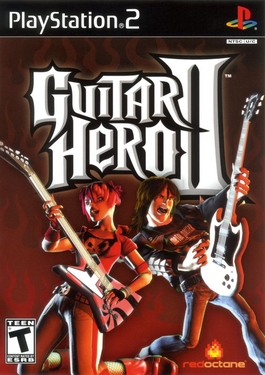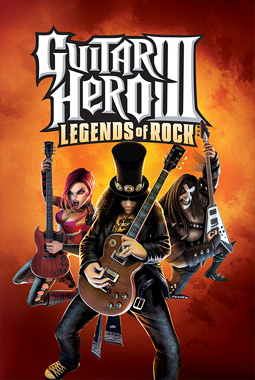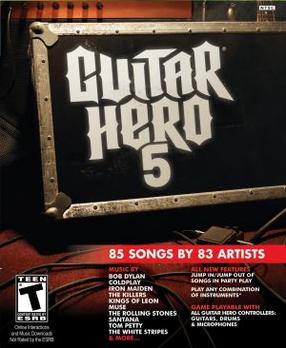 Hello and welcome to the Guitar Hero Megathread. A game where hitting a bunch of colours is actually hard as forget
Hello and welcome to the Guitar Hero Megathread. A game where hitting a bunch of colours is actually hard as forget_____________________________
_____________________________
_____________________________
__
The Guitar Hero series (sometimes referred to as the Hero series)[1] is a series of music video games first published in 2005 by RedOctane and Harmonix Music Systems, and distributed by Activision, in which players use a guitar-shaped game controller to simulate playing lead, bass guitar, and rhythm guitar across numerous rock music songs. Players match notes that scroll on-screen to colored fret buttons on the controller, strumming the controller in time to the music in order to score points, and keep the virtual audience excited. The games attempt to mimic many features of playing a real guitar, including the use of fast-fingering hammer-ons and pull-offs and the use of the whammy bar to alter the pitch of notes. Most games support single player modes, typically a Career mode to play through all the songs in the game, and both competitive and cooperative multiplayer modes. With the introduction of Guitar Hero World Tour in 2008, the game includes support for a four-player band including vocals and drums. The series initially used mostly cover version of songs created by WaveGroup Sound, but most recent titles feature soundtracks that are fully master recordings, and in some cases, special re-recordings, of the songs. Later titles in the series feature support for downloadable content in the form of new songs.
_____________________________
_____________________________
____________________________
NOTE:I will only be covering the main 5 games_____________________________
_____________________________
____________________________

Guitar Hero is a music video game developed by Harmonix Music Systems and published by RedOctane for the PlayStation 2 video game console. It is the first entry in the Guitar Hero series. Guitar Hero was released on November 8, 2005 in North America, April 7, 2006 in Europe and June 15, 2006 in Australia. The game's development was a result of collaboration between RedOctane and Harmonix to bring a GuitarFreaks-like game to America.
The game features a guitar-shaped controller (resembling a miniature Gibson SG) that the player uses to simulate playing rock music. The gameplay is similar to GuitarFreaks, in that the player presses buttons on the guitar controller in time with musical notes that scroll on the game screen. The game features covers of 30 popular rock songs spanning five decades of rock, from the 1960s up through 2005, in addition to bonus tracks. Guitar Hero became a surprise hit, earning critical acclaim and winning many awards from major video game publications, and was considered one of the most influential games of the first decade of the 21st century. The game's success launched the Guitar Hero franchise, which has earned more than $2 billion in sales, spawning several sequels, expansions, and other game-related products.
_____________________________
_____________________________
____________________________

Guitar Hero II is a music video game developed by Harmonix Music Systems and published by RedOctane. It is the second installment in the Guitar Hero series and is the sequel to Guitar Hero. It was first released for the PlayStation 2 in November 2006[1] and then for the Xbox 360 in April 2007, with additional content not originally in the PlayStation 2 version.[2]
Like in the original Guitar Hero, the player uses a guitar-shaped peripheral to simulate playing rock music as notes scroll towards the player. Most of the gameplay from the original game remains intact.,[3][4] provides new modes and note combinations. The game features more than 40 popular licensed songs, many of them cover versions recorded for the game, spanning five decades (from the 1960s to the 2000s).[5] The PlayStation 2 version of Guitar Hero II can be purchased individually or in a bundle that packages the game with a cherry red Gibson SG guitar controller. The Xbox 360 version of the game is offered in a bundle that packages the game with a white Gibson X-Plorer guitar controller. Both of these controllers are wired, but RedOctane also sells a wireless controller for the PlayStation 2.[6]
Since its release, Guitar Hero II has been met with both critical and commercial success, helping the Guitar Hero series become a cultural phenomenon.[7] As of December 1, 2007, the game has sold 3.1 million copies.[8] It has spawned the "expansion" title Guitar Hero Encore: Rocks the 80s for the PlayStation 2. A full-fledged sequel, Guitar Hero III: Legends of Rock, has been released by Neversoft, the makers of the popular Tony Hawk series.[9]
_____________________________
_____________________________
_____________________________

Guitar Hero III: Legends of Rock is a music video game, the third main installment in the Guitar Hero series, and the fourth title overall. The game was published by Activision and RedOctane, and is the first game in the series to be developed by Neversoft, after Activision's acquisition of RedOctane and MTV Games' purchase of Harmonix Music Systems, the previous development studio for the series. The game was released worldwide for the PlayStation 2, PlayStation 3, Wii, and Xbox 360 in October 2007, with Budcat Creations and Vicarious Visions assisting in the PlayStation 2 and Wii ports, respectively. Aspyr Media developed the PC and Mac versions of the game, releasing them later in 2007.
Guitar Hero III: Legends of Rock retains the basic gameplay from previous games in the Guitar Hero series, where the player uses a guitar-shaped controller to simulate the playing of lead, bass, and rhythm guitar parts in rock songs by playing in time to scrolling notes on-screen. The game, in addition to existing single-player Career modes, includes a new Co-Op Career mode and competitive challenges that pit the player against in-game characters and other players. Guitar Hero III: Legends of Rock is the first game in the series to include an online multiplayer feature, which is enabled in the Xbox 360, PlayStation 3, and Wii versions. Initially the game offers over 70 songs, most of which are master tracks. The Xbox 360 and PlayStation 3 versions feature the ability to download additional songs. The musicians Tom Morello (of the bands Rage Against the Machine and Audioslave) and Slash (of Guns N' Roses and Velvet Revolver) make appearances both as guitar battle opponents and playable characters in the game. The PC, PlayStation 3, and Xbox 360 versions also include Bret Michaels (of Poison) as a non-playable character.
Critics were generally favorable towards the game, but reviewers noted a difference in the game's style compared to previous installments, associating it with it being Neversoft's first development attempt with the series. The game is often cited to be too difficult, creating "walls of notes"[4] that are difficult to complete, and led to alterations in note placement for future games in the series were designed. According to Activision, Guitar Hero III: Legends of Rock is the best-selling video game of 2007, both in terms of units sold and revenue earned, and that it is the first single retail video game to exceed one billion dollars in sales. The company also claimed that it is the second-best selling video game title since 1995, following Wii Play, and is one of the best-selling third-party games available for the Wii.
_____________________________
_____________________________
_____________________________

Guitar Hero World Tour (initially referred to as Guitar Hero IV or Guitar Hero IV: World Tour) is a music video game developed by Neversoft and published by RedOctane and Activision. It is the fourth main entry in the Guitar Hero series. The game was launched in North America in October 2008 for the PlayStation 2, PlayStation 3, Wii, and Xbox 360 consoles, and a month later for Europe and Australia. A version of World Tour for Microsoft Windows and Apple Macintosh was later released.[1][2][4]
While the game continues to feature the use of a guitar-shaped controller to simulate the playing of rock music, Guitar Hero World Tour is the first game in the Guitar Hero series to feature drum and microphone controllers for percussion and vocal parts, similar in manner to the competing Rock Band series of games. The game allows users to create new songs through the "Music Studio" mode, which can then be uploaded and shared through a service known as "GHTunes".
World Tour received generally positive reviews with critics responding positively to the quality of the instrument controllers, the customization abilities, and improvements in the game's difficulty compared with the previous Guitar Hero III: Legends of Rock.
_____________________________
_____________________________
_____________________________

Guitar Hero 5 (initially referred to as Guitar Hero V) is a music video game and the fifth main entry in the Guitar Hero series. The game was developed by Neversoft and published by Activision, and released internationally in September 2009 for the Xbox 360, PlayStation 2, 3 and Wii consoles. Similar to the preceding title, Guitar Hero World Tour, Guitar Hero 5 is geared towards playing in a four-person band experience, including lead and bass guitar, drums, and vocals. The game is available as a standalone title, allowing players to use existing compatible instrument controllers, and as a bundle that provides these controllers. Guitar Hero 5 adds several new features, such as drop-in/drop-out play, bands composed of any combination of available instruments, a Rockfest competitive mode consisting of several various scoring mechanisms, and both song-specific and general Challenges to unlock new avatars, clothing, and other extras in the game. Many of these changes were added to make the game a more social experience, allowing players across a range of skill levels to be able to play cooperatively and competitively against each other both locally and online.
Guitar Hero 5's track list contains 85 songs by 83 separate artists, and like previous Guitar Hero games, several musicians with works in the game have been modeled through motion capture for playable characters in the game, including Johnny Cash, Carlos Santana, Shirley Manson, Matthew Bellamy, and Kurt Cobain. The game continues to support the user-created music studio introduced in World Tour through GHTunes, and additional downloadable content for the game was also made available. A majority of existing downloadable tracks from World Tour are forward-compatible with Guitar Hero 5, along with selected on-disc tracks from World Tour and Guitar Hero Smash Hits, and songs from the game could also be exported for a fee to play in its sequel, Guitar Hero: Warriors of Rock, and spin-off game Band Hero
The game was well received by reviewers, who appreciated the improvements in the accessibility of the game, allowing players to immediately jump in and play without spending excessive time in the game's menus. The game also sold well, however, it sold about less than 50 percent of Guitar Hero: World Tour's sales, specifically selling 1.2 million copies across all platforms. Improvements to both the Career and competitive multiplayer modes were also highlights of the game. However, the game's track list was considered to be too broad, and controversy arose over the ability to use the avatar of Kurt Cobain to perform in any other song within the game.
_____________________________
_____________________________
____________________________
Screenshots and stuff.

